When Robert Wilson, the renowned experimental theater director, performer, video artist and patron of the Watermill Center, was asked recently where he found his ideas, he replied, “Everywhere. The world is a library.”
If the world is, indeed, Wilson’s library, then the Watermill Center is his laboratory.
Each summer for the past 21 years, the Watermill Center has provided a unique environment where young and emerging artists from around the globe can come together and explore and develop new work. Fittingly, the theme for this year’s annual extravaganza (perhaps the most notorious event on the Hamptons summer calendar), aimed at raising the funds to keep Wilson’s “think tank” afloat, was “One Thousand Nights and One Night: Sleepless Nights of Scheherazade.”
At the stroke of 6 p.m. on Saturday, July 26, 2014, guests bedecked in silk pantaloons, gold lamé dresses and the perennially popular little black dress, gathered with colorful cocktails in hand to stroll through the trees, the verdant gardens and the human clouds to partake of the pageantry that is the hallmark of a night chez Wilson.
Of paramount importance to performance and installation art—and to Wilson’s brand—is the contortion and distortion of the human body, the modification and exaggeration of sound, and the disarrangement of narrative structure. Wilson’s unique addition to this oeuvre is his use of breathtaking visual imagery, derived and adapted from his early interest in opera and theater.
Aptly placed at the entrance to the forest behind Wilson’s 30,000-square-foot conversion of the former Western Union Laboratory, Francesca Fini’s piece, Liszt, serves the function of poetic gateway into the spectacular array of site-specific and collaborative pieces fabricated by this year’s resident artists.
Liszt is a large-screen video depicting a still family photograph of three early 20th century children. As we watch, this idyllic image of innocence—set against the soundtrack of a romantic composition by Franz Liszt—is digitally transformed in a mash-up that investigates loss of purity, violence, sex and miscommunication. Yet in the end, the final close-up of a single ear in Liszt seems to offer a message of hope. Certainly, this last shot encapsulated the symbolic message of the evening: “Listen and pay attention closely, beautiful worlds are about to be revealed.”
.
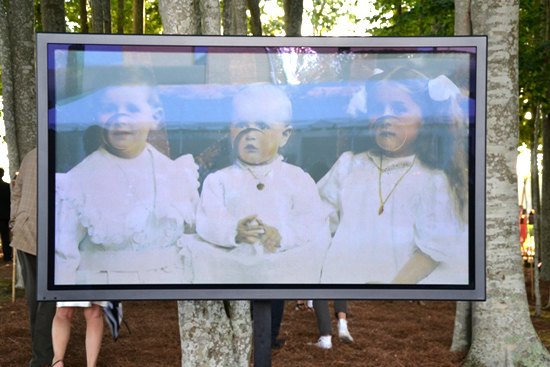
"Liszt" by Francesca Fini. Photo by Pat Rogers.
.
Among the most haunting works is Dorian Šilec Petek’s Stabat Mater: Passion. Here a woman clad in a white gauze chador and accompanied by two men on either side of her, who mist her with water from hoses attached to tanks on their backs, makes a stately promenade down an avenue lined in white neon. Ethereal, and sorrowful, Stabat Mater is a 13th century hymn to the Virgin Mary, a meditation on suffering and sacrifice that comes together in this performance when, at the end of her long walk, the chador clad mother of Christ unveils herself. Naked, she stands in front of a microphone and proclaims, “This is my body that gives itself to you.”
.
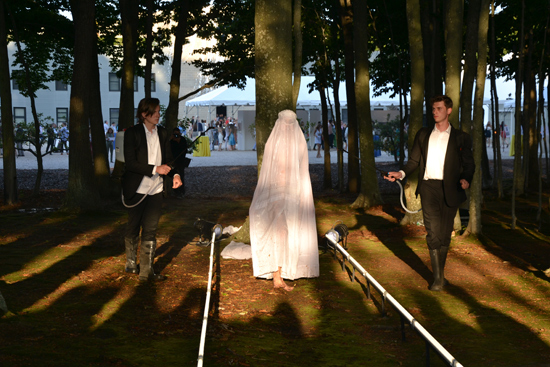
"Stabat Mater: Passion" by Dorian Šilec Petek. Photo by Pat Rogers.
.
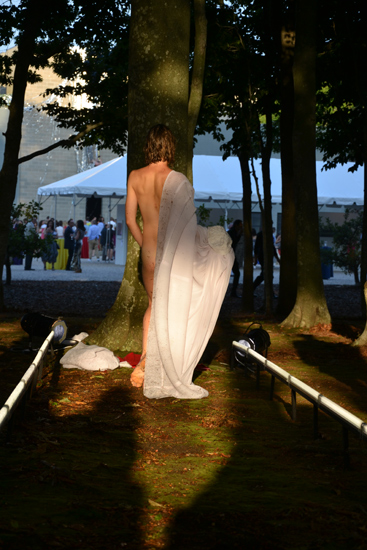
"Stabat Mater: Passion" by Dorian Šilec Petek. Photo by Pat Rogers.
.
Across the pathway, Francesca Fini performs, Fair and Lost. Wearing electrodes taped to both arms, Fini obsessively applies makeup while being shocked. A disturbing piece that comments on the female struggle to achieve perfection, Fini jerks in staccato rhythm as she hacks away at her own visage, her face devolving from glamorous to garish.
.
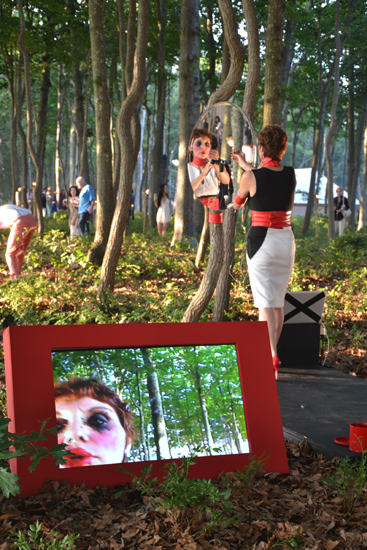
"Fair and Lost" performed by Francesca Fini. Photo by Pat Rogers.
.
Up in the trees, Alessandra Armenise threads herself into a red spider web. Naked save for the red yarn wrapped around her torso, Armenise slowly twists and turns, unraveling the coils from her body while at the same time entangling herself in the branches. Simple and elegant, this stark piece, with its associations to weaving, storytelling and destiny, calls to mind tales of weaving and the spinning of yarn and webs as various as the Greek myth of Arachne (hence arachnida, the class of animal that includes spiders), Rapunzel, Rumpelstiltskin, and Spider Man.
.
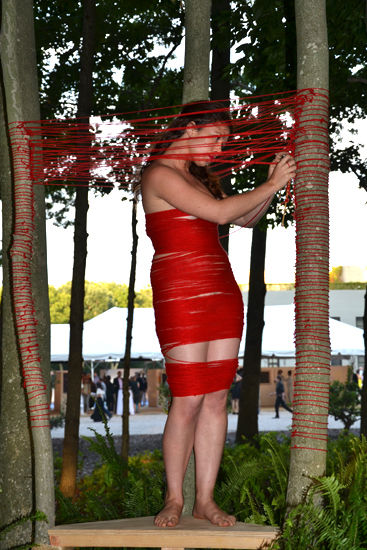
"Keep Talking To Me" performed by Alessandra Armenise. Photo by Pat Rogers.
.
In Mette Sterre’s installation, Hummelmania, a tribe of rubber band people gaily perform the imaginary task of typing on invisible typewriters. Wearing masks and bodysuits made entirely of rubber bands, Sterre’s sculptures come to life like animated cartoons along to a Disneyesque soundtrack. Similar to the soundsuits of artist Nick Cave, and to the great Walt Disney himself, Sterre is interested in using costumes and humor to anthropomorphize the material world.
.
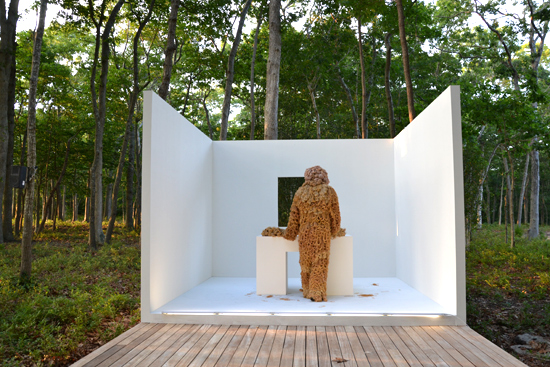
"Hummelmania" by Mette Sterre. Photo by Pat Rogers.
.
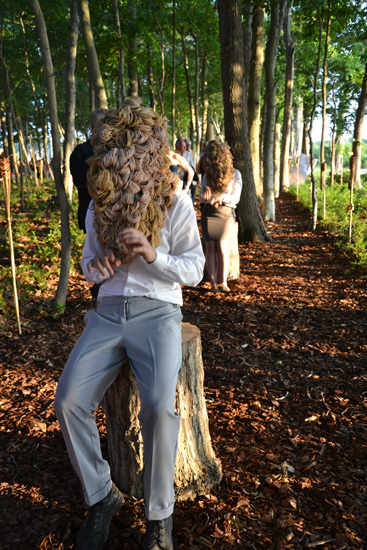
"Hummelmania" by Mette Sterre. Photo by Pat Rogers.
.
Nearby a head pokes out of the ground. This is Joelle Beli Titi wearing a garland of flowers on her head and singing opera in The Survival: How To Penetrate the Darkness. A few feet away, in a piece titled The Rest of the Tales by Fanny Lavergne, Anna Tilling sits in a plush red gown that becomes a part of the pillows below, inviting guests to have their pictures taken beside her, like one of the princess on a float in the Magic Kingdom. Fairy tales and their often darker Brothers Grimm versions seemed to be one of the major threads in the evening’s installations.
.

"The Survival: How To Penetrate the Darkness" performed by Joelle Beli Titi. Photo by Pat Rogers.
.
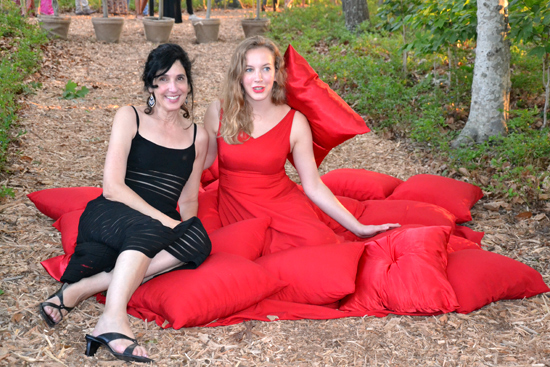
"The Rest of the Tales" by Fanny Lavergne is performed by Anna Tilling, on right, with writer and art critic Gabrielle Selz beside her, on left. Photo by Pat Rogers.
.
The highlight, though, was the theatrical masterpiece by avant-garde stage director, Dimitris Papaioannou. Papaioannou drew worldwide attention for his creative direction of the Opening and Closing Ceremonies at the 2004 Olympic Games in Athens. Last year at Watermill, he astounded viewers with his austere rendition of "Medea (2)".
This year, in his new work, "Sisyphus", an excerpt from the full-length piece "Still Life", Papaioannou again combines dance with a single object to create a mythic experience. This time it is Sisyphus struggling with a great, crumbling wall. At times the wall seems to devour Sisyphus, at other moments the wall appears to give birth to him. Minimal, directly concerned with the body and with the body’s place on the physical plane of the stage, as well as the metaphorical plane of the story, Papaioannou conjures simple, spellbinding magic.
.

"Sisyphus" by Dimitris Papaioannou. Photo by Pat Rogers.
.
Scheherazade told stories to a king that so bewitched him he fell in love with her and spared her life. The best stories, like the best performance art, have a simplicity of structure that is as inevitable as it is unexpected. Performance and installation art often seek to engage the viewer in the same way, by casting out the obvious and defying narrative expectations.
The artwork at Watermill Center, under Wilson’s tutelage, is derived from a recipe that focuses on the minimal, on contrast and on extremes, and this succeeds very effectively. Though they endeavor to disorient, these performances are mostly stark and stunning: snippets and fragments of stories that arrest us, and if we stop and pay attention, reveal the mundane, as well as the fabulous.
BASIC INFO: Watermill Center is located at 39 Watermill Towd Road, Water Mill, NY 11976. www.watermillcenter.org.
RELATED: To See a Slideshow of Sisyphus, click here.
_____________________________
Copyright 2014 Hamptons Art Hub LLC. All rights reserved.
